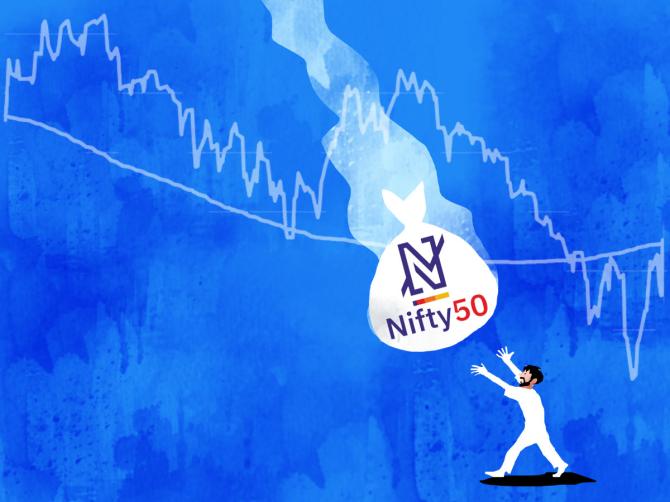Time to book profit now; buy when Nifty hits 16,000: BofA Securities
With the Nifty50 just about 3 per cent away from its all-time closing high of 18,812 points, analysts at BofA Securities suggest investors book profit.

Their reasons for the advice include risks like the possibility of a cut in corporate earnings growth forecasts, high valuation (one-year forward P/E of 19.5x), interest rates staying elevated for longer-than-expected and credit tightening.
Going ahead, they expect the Nifty50 index to drop to 16,000 levels – down nearly 12 per cent from the current level of 18,255 points, which they believe would be a good time to buy.
However, BofA Securities has kept its Nifty50 target unchanged at 18,000 levels for December 2023-end.
Global slowdown, volatile commodities, peak urban demand/slow rural revival are risks for earnings, BofA said, and expects continued cuts to consensus’ FY24/25 earnings growth.
“We see no upside to our Nifty year-end target of 18,000; would look to book profits.
“That said, we would advise buying potential market dips (Nifty50 at 16,000) on strong domestic flows, weak FII positioning (FII or foreign institutional investors’ ownership of NSE500 Index is down to 19.2 per cent in March 2023 versus 23 per cent in December 2019) and resilient India macro,” wrote the analysts, led by head of India research Amish Shah, at BofA Securities, in a co-authored note.
Among sectors, information technology (IT) remains their top underweight, besides staples (uncertain rural revival amid El Nino), discretionary (peaking urban demand) and telecom (low visibility on tariff hikes & higher 5G capex).
On the other hand, financials, industrials, cement/steel and select autos (two-wheelers) and utilities and healthcare are their preferred bets.
Fall of First Republic Bank – the third bank to fall in the US in the last two months after Silicon Valley Bank (SVB) and Signature Bank; debt ceiling risks by June; ongoing credit tightening & commercial real estate (CRE) weakness could be signs of an imminent US recession, BofA Securities said.
“Our analysis of the past two recessions (2001/07) suggests S&P fell 20-40 per cent after the onset of recession.
“The Nifty50 index, on the other hand, mimics S&P, though falls lesser.
“Economic growth contraction is less protracted for India at 1-3 quarters versus 2-7 for the US. India recovers faster as well, within 2-3 quarters versus 3-8 for the US,” Shah wrote.
Those at Rabobank International, too, expect the US economy to be in a recessionary phase in the second half of the 2023 calendar (H2CY23) and see the US Fed staying put with regards to rates after delivering a 25 basis point (bps) hike in its May 2023 meeting.
“We have been forecasting a US recession in the second half of 2023 since last year.
“In fact, we think a recession is inevitable if the Fed wants to get inflation back to its 2 per cent target rate.
“What’s more, the dependence of the FOMC on tightening credit conditions going forward has reduced the probability of a soft landing even further,” wrote Philip Marey, a senior US strategist at Rabobank International in a recent note.
Meanwhile, one of the consequences of the ripple effects from SVB, according to Christopher Wood, global head of equity strategy at Jefferies, has been renewed focus on the downturn in commercial real estate in the US.
“This is entirely understandable, given the structural threat to office property represented by the work-from-home phenomenon and given that small regional banks account for 70 per cent of domestically chartered commercial banks’ commercial real estate loans outstanding.
“And, it is regional banks which have of late suffered the biggest outflow of deposits.
“GREED & fear continues to believe that classic cyclical sectors, like banks, particularly large banks, energy and industrial commodities, will not be as vulnerable as would normally be expected if a recession does happen,” Wood said.
Disclaimer: This article is meant for information purposes only. This article and information do not constitute a distribution, an endorsement, an investment advice, an offer to buy or sell or the solicitation of an offer to buy or sell any securities/schemes or any other financial products/investment products mentioned in this article to influence the opinion or behaviour of the investors/recipients.
Any use of the information/any investment and investment related decisions of the investors/recipients are at their sole discretion and risk. Any advice herein is made on a general basis and does not take into account the specific investment objectives of the specific person or group of persons. Opinions expressed herein are subject to change without notice.
Source: Read Full Article

